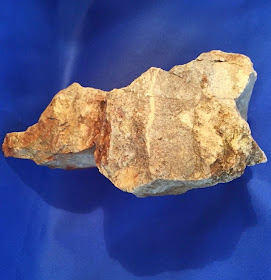Mammoth right profile figure standing upright on a flat base. Find by Adam Arkfeld, Arkfeld site, #44FK731, Clear Brook, Virginia
Ken Johnston illustration of the interpreted mammoth figure and a crude human face mask between the mammoth's front and hind legs. The mammoth has an eye in correct anatomical position and work to define and separate a trunk feature from the rest of the body seen at the straight line in the illustration.
The human face mask is a bust in this case with two eye cavities, a mouth with upper and lower lips and a squared off chin.
This is the third mammoth figure with a human face mask between legs from the Arkfeld site in a context of several dozen mammoth figures and many other portable rock pieces. Please see the posting just prior to this one and its included link to the first one from May 2014.
Incised eye creates another face mask
The artist incorporated a second larger face mask which shares the mouth of the smaller bust face mask. An open eye image has been incised into the stone and is highlighted in the illustration above. It created the right eye of the second human face figure while utilizing the mammoth eye as the left eye on the mask. Click on the photos to compare and toggle back and forth. Examine the two incised curved lines which meet on two ends to create a classic eye feature.































